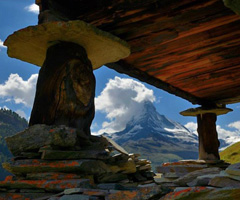|
More of the village's past can be found
on the
Wherwell Village website where you can buy a history of the
village on DVD.
A little further down Church Street from the home above is another
cottage from about the same period. At the junction of High Street you find yet another magnificent terrace of thatched cottages
(top right).
Click any of the [Google Map]
 buttons and take a street view tour of this picturesque ancient village.
buttons and take a street view tour of this picturesque ancient village. |
|
These cottages will very likely survive at least
another 500+ years, a testament to the
enduring quality of natural
materials. When these homes were built they used only natural
materials and repurposed materials from older buildings. The
curious mushroom like object in front of the cottage above are
called
Staddle Stones. They are used decoratively here but were
originally pillars on which a grain store would stand protecting
the grain from vermin and flood. The word 'staddle' is from Old
English stathol, a foundation, support or trunk of a tree. |
|
| |

|
Swiss Staddle
Stones |
|
|
| |
 |
|
|
|